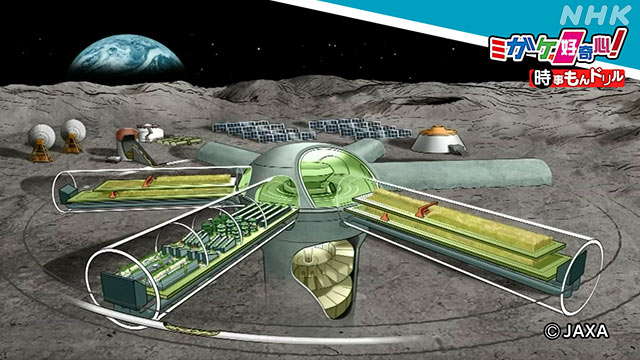Advance “Space Agriculture” December 1, 15:53
Europe's record-breaking drought, said to be the "worst in the past 500 years," occurred this summer.
Furthermore, in Japan, typhoons and record-breaking rains frequently cause agricultural damage.
As food security becomes a global issue, various studies on food production using new technologies are being conducted.
This time it is about the latest research on agriculture.
Challenge the problem!
The picture in question
is a state of vegetable cultivation using new technology.
What are the possible benefits of having vegetables grown in this way?
(J. F. Oberlin Junior High School 2022 Social Change Title)
The photo shows a facility called a plant factory that grows vegetables using hydroponic cultivation that does not use soil.
An example of an answer would be, "Because it is produced in an artificial facility, the production volume and quality can be kept uniform."
While research on agriculture such as plant factories is being conducted, research on "agriculture on the moon" is also progressing!
Advances in Space Development "Food Procurement" Becomes a Challenge
On November 16th, a large rocket carrying an unmanned spacecraft was launched for a test flight to the moon.
This is the first step of the international project "Artemis Project" aiming to land astronauts on the moon by 2025, and we are also looking at the construction of a "lunar base" in the future.
This plan is centered on the United States, with Japan participating.
As long-term stays on the moon become a reality, it is said that food supplies will be a problem ahead.
We asked Eiji Goto, a professor at Chiba University who studies food production in space.
Mr. Goto:
“It is very difficult to bring all the various things, including agricultural products, from Earth, so it is necessary to produce food locally. It is
What is the “Moon Farm Project”?
Therefore, the "Moon Farm" project, which produces food on the moon, was launched.
While research in this field is progressing in each country, Japan has started to take the initiative from 2021.
Private companies and research institutes are participating, and Mr. Goto is a sub-leader.
What kind of project is it?
Mr. Goto:
“I am researching how to create an underground farm and grow staple foods such as rice, soybeans, and potatoes, as well as side dishes such as tomatoes, strawberries, cucumbers, and lettuce in a small space.”
Here is an image of the lunar farm.
There is also a living space that assumes that 100 people live in a facility like a plant factory that cultivates rice and vegetables.
It will be built not on the surface of the moon, but underground by digging the surface of the moon.
Since the moon has almost no atmosphere, the sun's radiation falls directly on it, and the temperature difference between day and night is large.
Can rice grow properly in the harsh environment of the moon?
Mr. Goto is currently conducting repeated experiments in Japan using a "low-pressure cultivation device" that simulates the moon.
Furthermore, research into vegetable cultivation in outer space is already underway.
Last year, astronaut Akihiko Hoshide conducted a demonstration experiment of bag-grown lettuce at the Japanese Experiment Module "Kibo" on the International Space Station.
Mr. Goto:
Put only seeds and fertilizer in a flat bag, and add water in the spacecraft when you want to eat it. After about 30 to 60 days, germinate and root in the bag grows big
Since this lettuce can be loaded onto a spacecraft like a vacuum pack, it is thought that it can also be used to supply food during lunar exploration.
Research on lunar farms is also progressing in the private sector.
In February, a venture company in Aichi Prefecture participating in the project succeeded in cultivating Japanese mustard spinach in artificial soil made by processing sand close to the composition of the moon.
The grains of lunar sand are fine as they are, making it difficult for microorganisms essential for the growth of crops to live in, making it unsuitable for agriculture.
This company has found its own know-how in processing sand to activate microorganisms.
Since it is possible to convert lunar sand into soil suitable for agriculture without transporting earth's soil, expectations are high that it will open the way for lunar farms.
The era of “moon life” is right around the corner!?
Research on the moon farm is underway in various ways.
The time when we can live on the moon may be just around the corner.
Mr. Goto:
I think that a small lunar farm will probably be built in the 2030s.In 10 to 20 years, when 100 or 1,000 people will be staying here, they will be able to grow their favorite crops and use them. I have an image of eating at a restaurant and living happily together.”
By the way, I asked Mr. Goto, "Do the vegetables grown in space taste the same as the ones we eat?"
Mr. Goto was also involved in research on "bag-grown lettuce," but in fact he used it all for experiments and did not eat it.
However, according to the results of analyzing the ingredients, the taste and nutrients are the same as lettuce on the ground.
In "Migake, curiosity!" of "Weekly Maruwaki News" (broadcast at 8:25 am on Sundays), we delve into the news every week on topics such as current affairs presented in the entrance exam.
Let's think together about "why?"
On the corner homepage, you can also review the past.
Please take a look at the link below.
https://www3.nhk.or.jp/news/special/maruwaka-migake/

